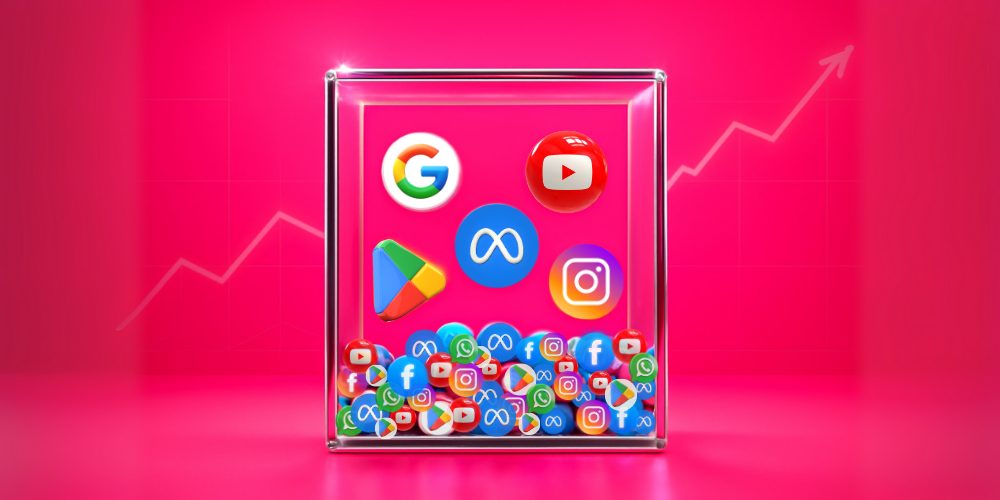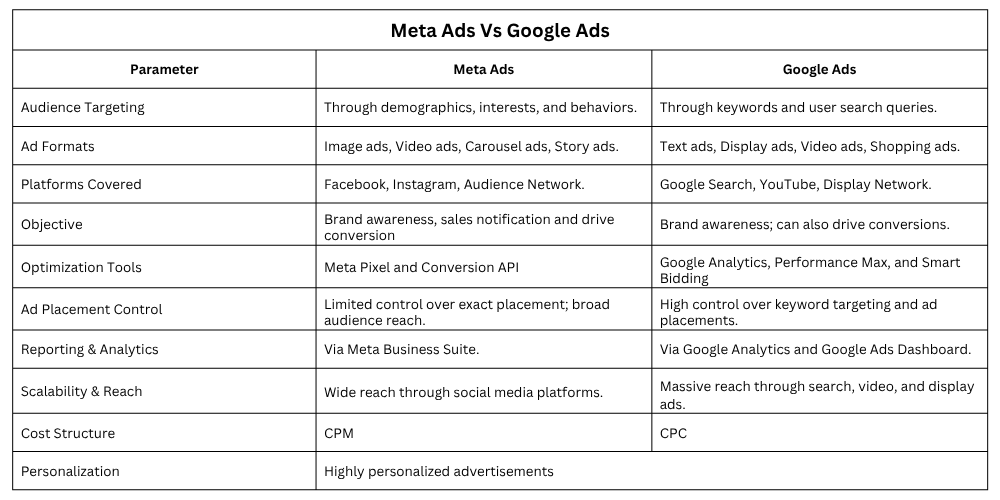
July 15, 2025 / admin
Meta & Google Ads: Performance Marketing Channels for Sales
For every business owner, the marketing funnel is a carefully designed roadmap to attract, engage, and convert potential customers. It is a step by step strategy to target and retarget your audience. The top section of this funnel is all about generating interest where users are actively researching, comparing, and exploring their options.
Google and Meta Advertising dominate the top of the funnel as they are used to create awareness around the brand and its products. These performance marketing channels are highly impactful due to their wider audience base.
This blog explores how Meta and Google Ads are powerful performance marketing tools and how they effectively target users in the research phase to the next step in the funnel.
Table of Contents
ToggleWhat is Performance Marketing?
Performance marketing is a result based digital marketing strategy where advertisers only have to pay when specific tasks are completed. These actions include clicks, conversions, sales, or other desired outcomes that are directly intended by the advertiser. In simpler words, performance marketing is marketing based on performance of a product or ad. Meta and Google Ads are two of the most prominent performance marketing channels amongst these others: Affiliate Marketing, Native Advertising, Email Marketing etc.
What are Meta Ads?
Meta Ads, previously known as Facebook ads, are the paid social media advertising techniques that businesses use to display their products and services to interested audiences. They appear in various formats including feed ads, video ads, right-column ads, and Marketplace ads (Facebook) and posts, reels, stories, and explore ads (Instagram).
These ads target users based on various factors such as demographics, interests, behavior, location, and even past interactions with similar content. With approximately 3.07 billion monthly active users on Facebook and 2 billion on Instagram (Statista, DataReportal), Meta Ads provide an expansive audience base for advertisers to engage effectively.
What are Google Ads?
Google SEO marketing plays a crucial role in organic visibility, while Search Engine Marketing (SEM) through Google Ads allows brands to appear at the top of search results instantly.
Google advertisements are displayed across Google search results, YouTube videos and Display network. These are customized paid search results based on user behavior, including search history, location, and interactions with previous content. This personalization ensures that users receive content most relevant to their interests and needs. This is why when you search the same keyword through different devices, your Google search results and rankings of those articles will be different across those devices.
To streamline advertising efforts, Google introduced Performance Max campaigns to access all Google Ads inventory from a single campaign. This approach helps deliver more conversions by optimizing ad performance in real-time across channels using Smart Bidding.

How Meta/Google read your history to show ads?
The Meta ad account is connected to the brand’s website for tracking user interactions (clicks, page views, conversions) and optimizing ads. It does so through tools like the Meta Pixels and Conversion Applications Programming Interface (CAPI) that help Meta figure out who’s just clicking around and who’s actually buying. Think of Pixel as a tiny piece of code added to your website that tracks user interactions (clicks, page views, conversions) and sends that data back to Meta. Meanwhile, CAPI works from the server side, making sure the tracking is accurate even if users have ad blockers or privacy settings on.
Google, on the other hand, uses search algorithms and tracks what you do across Google’s ecosystem (search, youtube, maps, all of it). It continuously evolves through frequent algorithm updates and Google SEO updates, refining how search results and ads are displayed. This helps Google understand user intent and preferences, allowing it to display relevant ads aligned with users’ interests. For instance, if you’re browsing news on Inshorts after searching for t-shirts online, you might encounter related ads there.
Why Does Performance Marketing Help?
Performance marketing uses the pull marketing technique to attract researching shoppers before they reach e-commerce platforms like Amazon and Flipkart for buying. When your ads across e-commerce sites plateau, performance marketing helps retarget users and helps enhance brand awareness.
Enhances brand awareness, strengthens identity, drives repeat purchases and increases brand recall
Performance marketing ensures your brand is visible where your audience spends most of their time i.e., Google and Meta platforms. Constant exposure through targeted ads initiates brand recall, making shoppers more likely to remember you when they’re ready to buy. Plus, by building a recognizable brand identity through consistent messaging, visuals, and offers, you nurture trust and when you repeatedly appear in front of the same audience, it drives not only conversions but also loyalty and repeat purchases.
Advanced filters customize campaigns by generation, gender, and behavior
One of the biggest strengths of performance marketing is how specific you can get with targeting. Platforms like Google and Meta allow advertisers to filter audiences based on age, gender, location, interests, and even online behaviors. It’s easy to target Gen Z women interested in fitness apparel or middle-aged professionals researching office gadgets. This precision targeting lets your ads reach the most relevant audience, increasing the likelihood of conversions.
Sales & promo ads create urgency and drive conversions
Sales and promotional ads are excellent for creating a sense of urgency. Flash sales, limited-time offers, and exclusive discounts all tap into the customer’s fear of missing out (FOMO). Performance marketing platforms excel at promoting these messages effectively that encourage shoppers to take immediate action. It’s like the online equivalent of a “Last Day of Sale” sign in a store window, just far more targeted and powerful.
Driving traffic to Amazon product listings
Meta Ads are great for sending traffic to your Amazon listings. If a particular product on Amazon is experiencing declining results, channelising users through Instagram and Facebook to Amazon products is the number one way to revive its performance.
Additionally, Amazon’s latest algorithm rewards external traffic. So, when you direct users from Meta Ads to your Amazon listing and they interact with it, Amazon boosts your organic ranking. This offers dual benefits: improving sales and enhancing visibility, making Meta Ads a powerful tool for listing health.
Indirect route to Amazon product listings
Even if your Google Ads bring people to your website, not everyone will hit the buy button immediately. Instead, they often hop over to Amazon to check if your brand is listed there. It’s simply because Amazon feels reliable. It’s familiar, offers quick shipping (especially if they have Prime), and has trusted reviews. For many customers, a solid Amazon presence reassures them that your brand is legitimate. So, while your website might be the starting point, Amazon often becomes the final destination for conversions.
Frequently Asked Questions
Should you drive traffic to Your Website or Amazon listings through Ads?
Google Ads are designed to drive traffic to your website. If you try running Google Ads targeting your Amazon listing, Google could flag your account, putting you at risk of suspension.
However, Meta Ads are highly effective for directing traffic to your Amazon listings, and Amazon’s algorithm even favours this external traffic.
Is Performance Marketing good for small businesses?
Performance marketing is budget-friendly and measurable because you only pay when you achieve results. With the right strategy about where, how and when to target, this becomes suitable for businesses of every scale. Partnering with a performance marketing agency can further streamline this process, ensuring optimized campaigns, precise targeting, and maximum ROI.
How to become a performance marketing expert?
Digital Marketing Courses and Certification help get a head start in this journey. However, hands-on experience teaches you real time campaign optimisation. At RB2F, we do exactly that. As a digital marketing and advertising agency, we create, test, and optimise campaigns on a daily basis to deliver required returns to our clients. If you’re serious about performance marketing and want to get real-world experience, drop us a mail with your resume. Who knows, we might be looking for someone like you!
Conclusion
At the end of the day, performance marketing with Google and Meta Ads is all about staying in front of your audience until they’re ready to buy. This isn’t equivalent to merely throwing money at ads but it’s an understanding where your audience is in their buying journey. Consequently, you can show ads when they matter. If you’re aiming to boost Amazon sales, Meta Ads will be a solid bet. They drive traffic, improve organic rankings, and build awareness. Just keep optimising, stay consistent, and make sure the messaging in your creatives and campaigns actually speak to your audience.